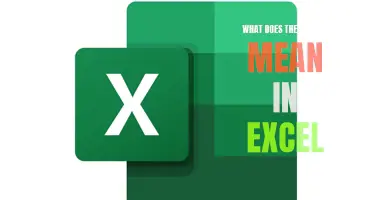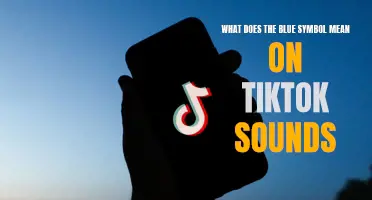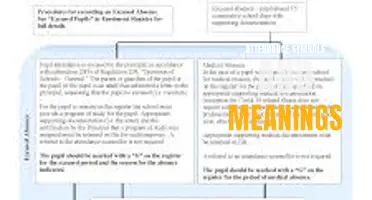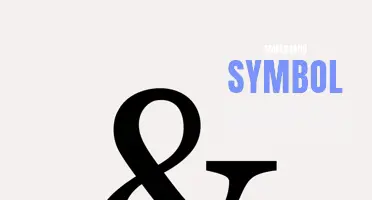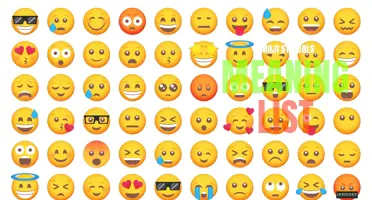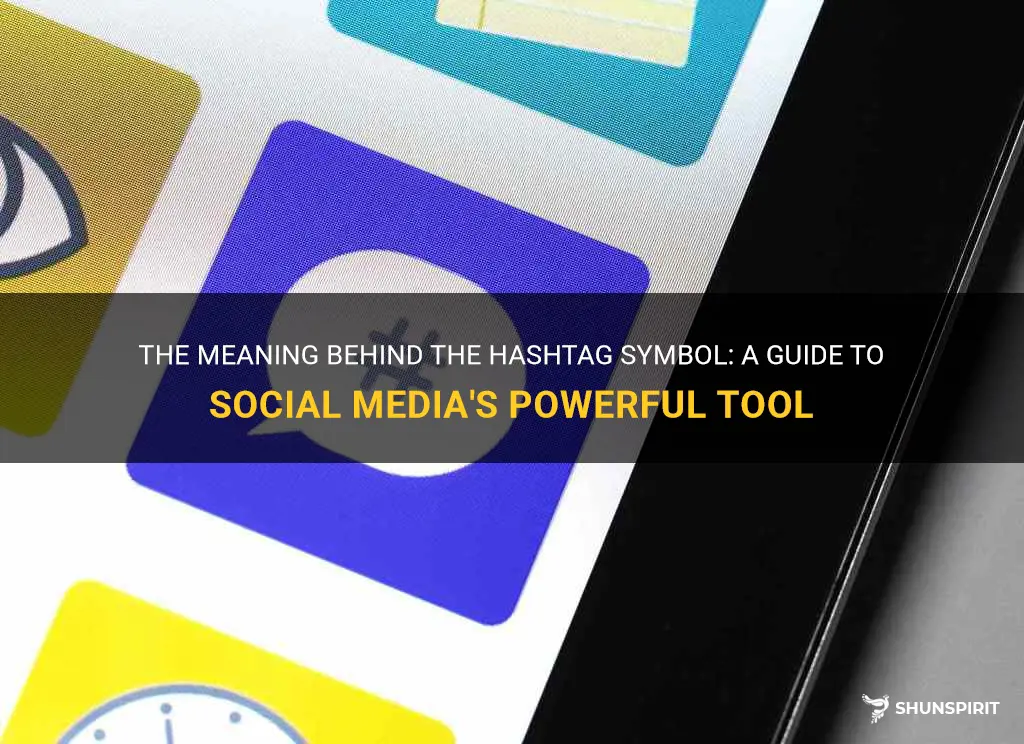
The hashtag symbol, also known as the pound sign or number sign, has become a powerful tool in the digital age. From being a simple symbol on a telephone keypad to a widely recognized online phenomenon, the hashtag has transformed the way we communicate, connect, and explore the vast landscape of social media. Whether used for organizing discussions, expressing solidarity, or simply adding a touch of whimsy to a post, the hashtag has morphed into a symbol with infinite possibilities. So what exactly does the hashtag symbol mean? Let's dig deeper into its history, its significance, and the impact it has had on our modern means of communication.
What You'll Learn
- What does the hashtag symbol (#) mean in social media?
- How is the hashtag symbol used to categorize content on different platforms?
- Are there specific etiquette rules for using hashtags in social media posts?
- How can hashtags be used effectively to increase discoverability of content?
- Has the meaning of the hashtag symbol evolved over time?

What does the hashtag symbol (#) mean in social media?
In the world of social media, you may have noticed the frequent use of the hashtag symbol (#) in many posts and updates. But what does it actually mean and what purpose does it serve? The hashtag symbol has become an integral part of social media communication, allowing users to organize and categorize their content, as well as participate in larger conversations and trends.
A hashtag is essentially a metadata tag that is used to label and group similar content together. It is created by prefixing a word or phrase with the hash symbol (#). For example, if you wanted to discuss the topic of food, you could use the hashtag #food. By including this hashtag in your post, it becomes clickable and allows users to easily find and discover other content related to food.
The primary purpose of hashtags is to make it easier for social media users to find content that interests them. When a user searches for a specific hashtag, they are presented with a feed of all the posts that have used that particular hashtag. This allows users to explore different topics, join relevant discussions, and engage with like-minded individuals.
Hashtags also facilitate conversations around events, trends, and popular topics. For example, during major events such as the Super Bowl or the Oscars, hashtags are used to aggregate conversations around these events. This allows users to follow along and participate in real-time discussions, enhancing the overall experience.
In addition to discovery and conversation, hashtags are also used as a marketing tool. Businesses and brands often create their own unique hashtags to promote their products or services. By encouraging their audience to use their custom hashtags, they can track and measure the reach and engagement of their marketing campaigns.
When using hashtags on social media, it is important to remember a few best practices. First, it's recommended to use relevant and specific hashtags rather than general ones. This will help ensure that your content reaches the right audience. Second, it's best to keep the number of hashtags per post to a manageable amount. While there is no set rule, using too many hashtags can appear spammy and may turn off users. Finally, it's important to stay up to date with trending hashtags and to join relevant conversations when appropriate. This can help increase your visibility and engagement within the social media community.
In conclusion, the hashtag symbol (#) in social media serves as a way to organize and categorize content, as well as engage in conversations and trends. By using hashtags effectively, social media users can discover new content, participate in discussions, and promote their own brand or content. So the next time you see a hashtag, don't hesitate to join the conversation and explore the multitude of possibilities that social media has to offer.
Exploring the Symbolic Meaning of Medusa: Unraveling the Myth of Power and Femininity
You may want to see also

How is the hashtag symbol used to categorize content on different platforms?
The hashtag symbol, also known as the pound sign or number sign, has taken on a new meaning in the digital age. It has become an essential tool for categorizing and organizing content on various social media platforms. By using hashtags, users can easily search for and engage with specific topics of interest, opening up a whole new world of content discovery and conversation.
Hashtags were first introduced on social media platforms like Twitter back in 2007. They served as a way to group and organize tweets around specific topics. Soon, other platforms like Instagram, Facebook, and LinkedIn adopted the use of hashtags, further expanding their popularity and functionality. Today, hashtags have become ubiquitous, allowing users to quickly find and contribute to discussions on virtually any subject.
The concept behind hashtags is simple. Users can include the hashtag symbol (#) followed by a word or phrase in their posts. This creates a clickable link that takes users to a feed or search results page displaying all the posts that have used the same hashtag. For example, if someone posts a photo of their vacation with the hashtag #travel, their post becomes discoverable to anyone searching for or clicking on the #travel hashtag.
Hashtags have proven to be an effective way for content creators to reach a wider audience. By including relevant and popular hashtags in their posts, creators can increase the visibility and discoverability of their content. It's not uncommon to see influencers and businesses strategically using hashtags to maximize their reach and engagement.
Moreover, hashtags have been used for various purposes beyond content organization. They have become instrumental in launching digital campaigns and movements, raising awareness for social issues, and promoting events. A single hashtag can unite people from all walks of life, allowing them to share their experiences and contribute to a larger conversation.
However, it's important to note that not all hashtags are created equal. Some hashtags may be generic and overly popular, resulting in a crowded feed where it's difficult to get noticed. On the other hand, using more specific and niche hashtags can yield better results by targeting a smaller but more engaged audience.
To help users find the most relevant and trending hashtags, social media platforms have introduced features like hashtag suggestions and trending topics. These tools recommend popular and related hashtags based on user behavior and current conversations. This makes it easier for users to discover new content and join relevant discussions.
In conclusion, the hashtag symbol has revolutionized content categorization and discovery on social media platforms. It has provided users with a powerful tool to organize, search, and engage with specific topics of interest. By incorporating hashtags into their posts, content creators can expand their reach, while users can explore a world of diverse content and contribute to meaningful conversations. The hashtag symbol truly represents the interconnectedness and collective nature of the digital age.
Unraveling the Mystical Meaning and Symbolism Behind Shooting Stars
You may want to see also

Are there specific etiquette rules for using hashtags in social media posts?
Hashtags have become an integral part of social media culture. They help users categorize their content and make it discoverable by a wider audience. However, there are certain etiquette rules that one should keep in mind when using hashtags in social media posts. These rules can significantly impact the effectiveness of your hashtag usage and ensure that you are engaging with your desired audience.
First and foremost, it is important to understand the purpose of hashtags. Hashtags act as a way to tag and categorize your content, making it easier for others to find. When using hashtags, it is essential to make them relevant to your post. Using popular or trending hashtags simply for the sake of popularity can come across as inauthentic and spam-like. Instead, try to use hashtags that are relevant to your content and will help you reach your target audience.
It is also essential to keep your hashtag usage to a reasonable number. While Instagram allows for up to 30 hashtags per post, bombarding your post with too many hashtags can make it look cluttered and desperate for attention. It is recommended to use a smaller number of highly relevant hashtags that will help your content be discovered by the right audience. This will also make your post look more professional and aesthetically pleasing.
Another crucial rule for using hashtags is to research and understand the meaning and context behind them. Hashtags can have different meanings and connotations, and using them without fully understanding their implications can be harmful. Take the time to research and ensure that you are using hashtags that align with your brand and values. This will help you avoid any potential backlash or misunderstanding from your audience.
When using hashtags, it is also essential to engage with the community. Hashtags act as a way to connect with others who have similar interests or are discussing a particular topic. By using relevant hashtags, you can join the conversation and engage with others who are interested in similar content. Take the time to like and comment on posts that use similar hashtags, and you may find that your engagement and reach increase significantly.
Lastly, it is important to monitor and measure the effectiveness of your hashtag usage. Pay attention to the engagement and reach of your posts when using specific hashtags. This will help you determine which hashtags are most effective at reaching your target audience and driving engagement. Use this data to refine your hashtag strategy and continually improve your social media presence.
In conclusion, there are specific etiquette rules for using hashtags in social media posts. By making your hashtags relevant, using a reasonable number, understanding their meaning, engaging with the community, and measuring their effectiveness, you can optimize your hashtag usage and achieve better results in reaching your desired audience. Remember to be authentic and intentional with your hashtag usage, as this will ensure that you are using hashtags effectively and contributing positively to the social media landscape.
What Does the Biohazard Symbol Mean: Understanding Its Significance in Safety
You may want to see also

How can hashtags be used effectively to increase discoverability of content?
In today's digital world, hashtags have become an integral part of social media platforms. They are not just a way to add a trendy phrase to a post, but they are also a powerful tool to increase the discoverability of content. When used effectively, hashtags can help your content reach a wider audience and improve engagement. Here are a few tips on how to use hashtags effectively to increase the discoverability of your content:
- Choose relevant hashtags: The key to using hashtags effectively is choosing ones that are relevant to your content. Research popular hashtags within your niche and industry and choose the ones that best represent the topic or theme of your post. Using relevant hashtags makes it easier for people who are interested in a particular topic to find your content.
- Use trending hashtags: Keeping up with the latest trends can help your content gain more visibility. Using popular and trending hashtags can put your content in front of a larger audience. Platforms like Twitter and Instagram often display trending hashtags, allowing you to join the conversation and increase the likelihood of your content being discovered by new users.
- Create a branded hashtag: If you have a business or personal brand, creating a branded hashtag can help increase brand awareness and make your content more discoverable. Choose a unique hashtag that represents your brand and use it consistently across your social media posts. Encouraging your followers to use your branded hashtag can also help in spreading the word about your brand.
- Research your competitors: It's a good idea to keep an eye on what hashtags your competitors are using. By researching your competitors, you can identify popular hashtags within your industry, discover new trends, and even find inspiration for your own content. However, be sure not to use the same hashtags as your competitors, as this can lead to confusion and dilute your unique identity.
- Experiment with niche hashtags: While using popular hashtags can increase the visibility of your content, using niche hashtags can help you reach a more targeted audience. Niche hashtags are specific to a particular topic or industry, and they may have a smaller but more engaged audience. By using niche hashtags, you can connect with like-minded individuals who are genuinely interested in your content.
- Analyze your hashtag performance: It's essential to regularly analyze the performance of the hashtags you're using. Most social media platforms offer insights and analytics to help you understand which hashtags are driving engagement and which ones are not. By analyzing your hashtag performance, you can refine your strategy and identify the best hashtags to use for future posts.
In conclusion, hashtags can be a powerful tool to increase the discoverability of your content. By choosing relevant and trending hashtags, creating a branded hashtag, researching your competitors, experimenting with niche hashtags, and analyzing your hashtag performance, you can reach a wider audience, improve engagement, and ultimately increase the discoverability of your content. So, start using hashtags strategically and watch your content soar to new heights.
The Hidden Meanings Behind WhatsApp Symbols and Emojis
You may want to see also

Has the meaning of the hashtag symbol evolved over time?
The hashtag symbol, also known as the pound sign or number sign, has indeed evolved in its meaning over time. Originally used primarily in telecommunications to denote numbers, the symbol gained prominence in the early 2000s with the rise of social media platforms such as Twitter and Instagram. Today, it is widely recognized as a way to categorize and organize content on social media.
In the pre-social media era, the hashtag symbol was mainly used to indicate numbers. In the telecommunications industry, it denoted the same meaning: a number or quantity. It was used on touch-tone telephone keypads and on dial-up modems to represent the number sign or the pound key. It had no affiliation with categorizing content or creating a search feature.
However, with the rise of social media platforms, particularly Twitter, in the late 2000s, the hashtag symbol took on a new meaning. Twitter users started using the symbol to create a form of metadata or tag for their tweets. By adding the hashtag before a word or phrase without spaces, users could categorize their tweets and make them discoverable by others interested in the same topic.
This new usage of the hashtag symbol quickly caught on and became a way to track and follow conversations on various topics. As social media platforms expanded, the hashtag symbol became a standard feature, allowing users to click on a hashtag and see all the other posts and discussions related to that topic.
The hashtag's evolution continued as other social media platforms, such as Instagram and Facebook, adopted the feature. Instagram, in particular, embraced the hashtag culture, with users extensively using hashtags to reach a wider audience and increase the discoverability of their posts.
Today, hashtags have become a common part of social media language and culture. They are used not only to categorize content but also to express thoughts, feelings, and trends. Hashtags are frequently used to participate in or follow conversations surrounding current events, campaigns, movements, and popular culture. They have been used to raise awareness, create communities, and even spark social and political movements.
In recent years, the hashtag symbol has expanded beyond the realm of social media. It is now commonly used in advertising campaigns, television shows, and even everyday conversations. Its widespread adoption and understanding make it a powerful tool for communication and information sharing.
The evolution of the hashtag symbol demonstrates how the use of a symbol or character can evolve and take on new meanings over time. From denoting numbers in early telecommunications to becoming a powerful tool for content discovery and community building on social media, the hashtag symbol has become an integral part of our digital age. Its continued evolution and widespread use are a testament to its adaptability and significance in our modern-day communication.
Understanding the Meaning of Honda CR-V Dashboard Symbols: A Comprehensive Guide
You may want to see also
Frequently asked questions
The hashtag symbol, also known as the pound sign or number sign, is used to categorize and group posts on social media. When followed by a word or phrase without spaces, the hashtag becomes clickable and allows users to easily search for and find other posts with the same hashtag. This makes it easier for people to discover and engage with content that is relevant to their interests.
Hashtags are used to organize and filter content on social media platforms. They help users discover posts related to specific topics or interests by clicking on a hashtag. This allows people to participate in conversations and communities centered around a particular subject. Hashtags can also be used for marketing purposes, as businesses and influencers can create their own branded hashtags to promote their products or services.
While the basic concept of hashtags is the same across different social media platforms, there are some variations in how they are used. On platforms like Twitter and Instagram, hashtags are used to categorize and search for content. On Twitter, for example, hashtags enable users to follow trending topics or participate in discussions by adding relevant hashtags to their tweets. On Instagram, hashtags are commonly used to increase visibility and reach, as users can search for specific hashtags and discover posts that use them. On platforms like Facebook and LinkedIn, hashtags are less commonly used and tend to have a smaller impact on content visibility.



